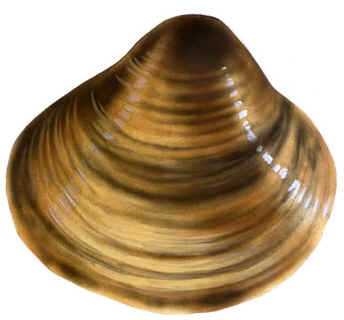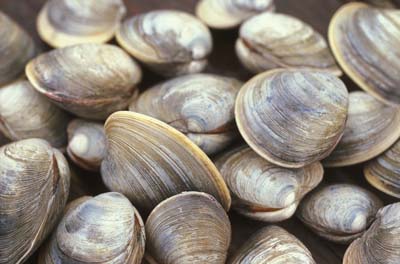
Clams and oysters have long been of value to
humans as food, while their shells have been
valued as ornamentation. Paleolithic shell middens,
some twenty-five feet high and seventy feet
in base diameter, consist almost entirely of the discarded
shells of clams and oysters. Oysters were
especially prized because they lay on the surface
of the estuary bottom and were easily gathered.
Clams, buried a few inches deep, required some
effort to gather. To prepare the shellfish for food,
they were often simply placed on a fire and
roasted in the shell. The fleshy contents were removed,
eaten as they were, or cooked in a stew
with some vegetables.
Physical Characteristics of Clams and Oysters
There are more than fifteen thousand different
species of clams worldwide. They range in size
from the Condylocardia, about 0.004 inches long, to
the giant clam (Tridacna gigas) of the southwest Pacific
Ocean, which grows up to nearly five feet
long and weighs about 550 pounds.
Classified as bivalves, the animals have two
shells that protect the soft body parts. In clams,
two syphons, one incurrent and one excurrent,
draw in and discharge seawater. The water supplies
the shellfish with oxygen as well as plankton
and other organic matter for food. A muscular
projection (the foot) enables the clam to burrow
into the sandy bottom. The valves are held together
by two adductor muscles that slowly contract
and relax to pump water into the shell. When
the shellfish senses danger, the adductor muscles
contract, closing the valves tightly and effectively
sealing the soft body parts from a potential predator.
Oysters vary in shape depending on the type of
bottom on which they lie. The shells usually are
elongated with a rough surface. They do not have
siphons. Instead, seawater, containing food organisms,
is drawn into the body by a pumping action
of the valves. Oysters do not have a foot and
are sessile.
The Life Cycle of Clams and
Oysters
In clams and oysters, the sexes
are separate and spawning is
triggered by favorable water
temperature. The eggs and
sperm, several hundred thousand
to several million each,
are broadcast into the water
through the excurrent siphon.
Of the millions of eggs, only
a very few reach adulthood;
many fail to be fertilized, some
are eaten by small fishes and
other predators,somesuccumb
to molds and bacteria, and
some adults are eaten by eels,
sea stars, and whelks. Each
year, more than 112 million
pounds of clams and nearly 26
million pounds of oysters are
taken for human food.
Shellfish that grow in polluted waters may ingest
disease organisms which accumulate in their
tissues. These can cause disease in humans. Some
toxic plankton may cause illnesses, such as paralytic
shellfish poisoning in humans who eat the
clams or oysters uncooked ("on the half-shell").
Commercially canned shellfish are cooked under
pressure and are safe to eat. The incidence of human
illness from eating toxic clams is very low.
One species of clam, the teredo, or shipworm, burrows
into wood and leaves it honeycombed.
Pearls
Most clams and oysters produce pearls but not all
are of gem quality. The pearl is made of the same
material as the lining of the shell. It is deposited
around some irritant such as a grain of sand. The
giant clam produces pearls as large as golf balls.
Clams and Oysters Facts
Classification:
Kingdom: Animalia
Phylum: Mollusca
Class: Bivalva, with ten orders, fifty-seven families
Geographical location: Worldwide
Habitat: The bottom of all marine waters, from
coastal subtidal to great depths of the sea
Gestational period: Larval stage varies according
to species but generally lasts around one
month
Life span: For the edible clam (quahog), harvest
occurs in three to five years; some researchers
estimate a life span of up to three hundred
years for this species, if it is not eaten
Special anatomy: Shape of the shell varies only
slightly and is generally roundish; lips of the
Tridacna shell are wavy; some species have a
powerful tongue or foot that enables the clam
to dig quickly into the sandy bottom to escape
predators
Other popular Animals
Photo Gallery of - Clams and Oysters








 Animalia Life
Animalia Life